 |
 |
|
|
Last Updated: 5/10/17
Egg Photos
Egg Introduction
Egg Identification Guide
Note: This guide was created from spring of 2002 until 10/16/02 and may contain errors, omissions, etc. If you find an error or think I should add in an animal I have neglected, please contact me.

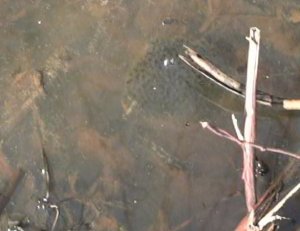
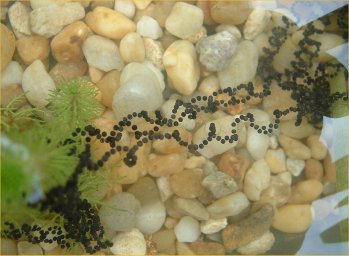
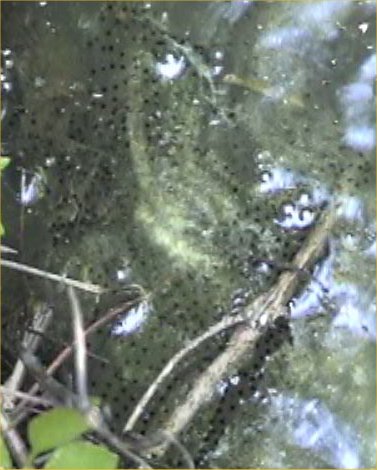
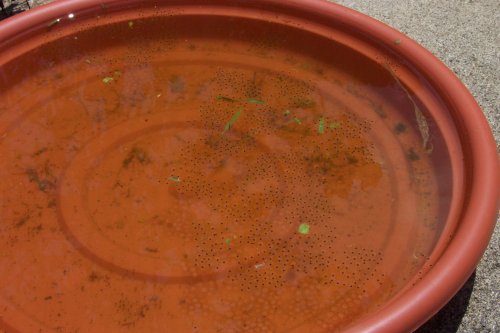

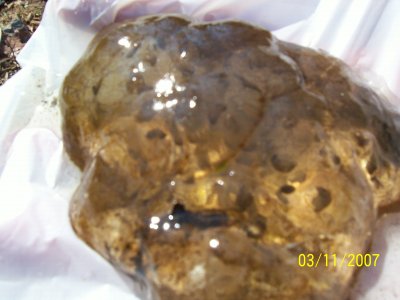
On 3/11/07, Amber sent these photos to me for identification. They are salamander eggs
laid in her pond in Georgia. Three globs were resting on a shelf a foot under the water that they
found when they cleaned the pond. One of the four photos is shown above; here are three
more.
Salamander eggs
Salamander eggs
Salamander eggs
Alan sent this e-mail in regards to the above photos on 4/10/07. I agreed with him and was
aware of what he says.
"On your Pond Egg Identification Page you show a salamander egg mass that you received from
Amber and dated 3/11/07. This is almost undoubtedly an egg mass of the Spotted Salamander
(Ambystoma maculatum) for two reasons. First, the size and shape of the egg mass
are pretty characteristic; also the time of year is just right for their breeding. This is a very
attractive and not uncommon salamander but it is rarely seen during 99% of the year because it
is
active at night and spends the rest of its time in a burrow. But on the first warm spring night
when there is a rain the spotteds gather together in hundreds at pools and mate and lay eggs. The
pools are usually temporary pools that do not have fish."
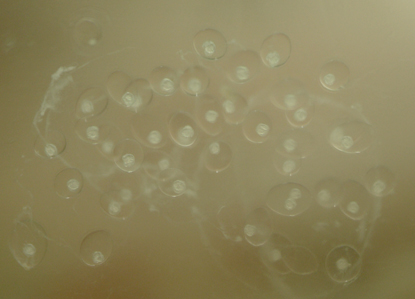
On 4/1/08, I cleaned out my 153 gallon pond and took photos
of some snail eggs on my Lerio pots. They are probably ramshorn snail eggs (although there
were some pond snails and Melantho snails in the pond too. The eggs for all three species look
basically the same.)
Snail eggs on a two gallon Lerio pot.
Close up of snail eggs from the previous
photo.
Snail eggs on another two gallon pot.
From the 3/31/10 cleaning of my 153 gallon pond:
Snail eggs on a two gallon Lerio
pot; they are black ramshorn snails.
Snail eggs
Snail eggs
Go to my salamander page for additional photos of salamander eggs.
On 3/10/11, David sent me these photos of "eggs" in a fast-moving stream in California. They
were air bubbles. I wrote the following in response to someone with a pond who asked the same
question a few days earlier:
"They're bubbles. As the pond warms, the algae start to grow more, and the bacteria in the pond
start
to degrade the debris in the pond more. So, on surfaces with algae and/or bacteria (basically any
surface), bubbles will form. Algae produce oxygen during the day and carbon dioxide at night. I
get
those bubbles all in my marine tanks during the day from algal photosynthesis and sometimes in
my ponds
in the spring. Any organic material in the pond will be attacked and digested by enzymes and
bacteria.
Anaerobic bacteria live where oxygen levels are low and produce hydrogen sulfide and methane
gases as
by-products. The first smells like rotten eggs while methane is odorless. Both will cause
bubbles to
form and both are toxic at high enough levels. For this reason, it's important to keep a pond free
of a
lot of organic waste (dead plants and animals) and well oxygenated even in the winter with air
stones or
other water movement such as a waterfall if the setup and climate allows. Anyway, the bubbles
are going
to be from a combination of photosynthesis and bacterial processes....Touch the bubbles, and
they'll vanish.
If you don't already have aeration in
the pond, I suggest adding it. That should reduce the bubbles which are simply gas pockets
where algae
and/or bacteria have produced enough gas to cause a bubble which is in equilibrium with the
water. The
gas in the bubbles may include oxygen, carbon dioxide, methane, and/or hydrogen sulfide. The
bubbles
eventually break or float to the surface."
Bubbles in a stream
Bubbles in a stream
Here are photos from 5/26/12 of gray treefrog eggs that I collected from the pool cover. You can
also see mosquito larvae or at least one on the right. Some of the tadpoles have hatched already
(just a few).
Gray treefrog eggs
Gray treefrog eggs - close-up
Charles sent these photos on 5/5/12 of eggs for identification. They are perch eggs, probably
yellow perch.
Perch eggs
Perch eggs
Perch eggs
See the bottom of my insect page for information and photos of some eggs that I could not readily identify. They are probably caddisfly eggs.

If you have a watergarden or pond, you will be forever finding various eggs in and around the pond. Some are small; some are large. Some are in clumps; some are laid singly. Some are colored; some are plain. But they all will eventually result in the birth of a new generation of something. But what? Perhaps the guide below will narrow things down for you.
If you cannot find out what eggs you have from my guide, then send me the answers to these questions with your query. It would help to have a small jpg photo (in focus and with something to tell the relative size of the eggs) if you contact me.
A few non-egg things are often mistaken for eggs. These include bubbles (normally bunched in a stream around algae), bryozoans (which are colonial animals), waterlily seeds (which are in a gelatinous slimy pouch), and other plant seeds.
1. Are the eggs in a ball/glob?
For links to the egg-laying pond animals on my web pages, go to my pond
index.
This guide is for the Eastern United States but may help narrow things down for residents of
other
areas as well. You can click on the highlighted animals for pages with information on them.
This
guide assumes that you know that what you are looking at is actually an egg and not something
else (plant, fungus, inert, etc.). You may also be required to have heard noises in order to
find the solution. If you have heard no noises, when there is a question about having heard
something, you will need to try all the options for further questions to narrow things down.
For photos (and information and sometimes calls for frogs) of species of wild animals native to
your
area if you live in the USA, try enature.com where you
can
enter in your zip code to find animals in your specific area.
In general, frog eggs float and are a circular mass; salamander eggs sink, are huge masses with
lots of
jelly, and may or may not be attached to plants or sticks; and toad eggs are midwater attached to
plants
and sticks and are laid in a string. While amphibian eggs are found in masses, fish eggs and
other
eggs
may be found individually or in small groups.
1. Is the egg mass above or below water? If on land, go to Number 2. If in the water, go to
Number 9.
2. Is the mass large, kind of dry, and pink or yellow? If so, then go to Number 3. If not, go to
Number 4.
3. Congratulations! You most surely have apple snail
eggs. Their eggs are laid above water on plants or rocks.
4. Are the eggs small, hard, and black and on the rocks? If so, go to Number 5. If not, go to
Number 6.
5. I have these hard black dots all around my rocks. I believe they are not eggs but the
overwintering hibernaculums of the tiny red mites that cover the rocks in the summer. I am not
positive though!
6. Are the eggs very tiny, black, and laid on the plants? If so, go to Number 7. If not, go to
Number 8.
7. These are most likely insect eggs. There are many possibilities so to narrow it down further
requires an entomologist specializing in this area.
8. Are the eggs large and white and on the ground or buried in the dirt or sand? If so, go to
Number 39. If not, go to Number 37.
9. Are the eggs floating and not attached to anything or only loosely attached? If so (not
attached), go to
Number 10. If not (they are attached or sink), go to Number 25.
10. Is the egg mass smaller than two inches across? If so, go to Number 11. If not, go to
Number 43.
11. Is it late winter into early spring? If so, go to Number 12. If not, go to Number 17.
12. Have you heard cricket-like chirping recently? If so, go to Number 13. If not, go to Number
14.
13. These may be the eggs of the spring peeper.
They are only a inch or so across.
14. Have you heard duck-like quacking recently? If so, go to Number 15. If not, go to Number
16.
15. You must have eggs of the wood frog. Their circular
egg masses are 2-4 inches across. The tadpoles are very small.
16. The eggs probably belong to another small frog (or you missed the others calling) such as
the
cricket frog, chorus frog, or
ones native to your area.
17. Is it late spring, and you have heard loud (some would say irritating) noises from the pond at
night? If so, go to Number 18. If not, go to Number 19.
18. These may be the eggs of the gray tree frog. Their
circular egg masses are 2-3 inches across.
19. I am not sure which species these eggs belong to but it is probably frog eggs.
20. Have you heard noises like the twang of a banjo string? If so, go to Number 21. If not, go
to Number 22.
21. You may have green frog eggs. Their egg masses are
usually circular and about 4-6 inches across.
22. Does a loud "blah, blah" come from the pond, mostly after dark? If so, go to Number 23. If
not, go to Number 24.
23. Sounds like you have bullfrogs and perhaps bullfrog
eggs.
24. Is the egg mass round like a ball (not flattened) and over about three to four inches in
diameter? If so, go to Number 41. If not, go to Number 42.
25. Are the eggs laid in a long string with black dots along the edge and draped around the
vegetation in the pond in spring? If so, go to Number 26. If not, go to Number 27.
26. Congratulations! You have toad eggs. See my toad page for
lots
more information.
27. Are the eggs in a large jelly-like blob mass that sinks to the bottom or is among plants and
found in late winter or early spring? If so, go to Number 28. If not, go to Number 29.
28. Sounds like you were lucky enough to be visited by salamanders (or rarely newts)! See my
page on salamanders for more information. Salamander eggs will
stay
around
for a while after they hatch but start to decompose and turn white and dirty.
29. Are the eggs in a jelly-like blob (the jelly extends over all the eggs, not just a single egg) and
attached to a plant, ornament, etc.? If so, go to Number 30. If not, go to Number 31.
30. Are the eggs relatively small, typically half an inch or less but certainly less than an inch
long? If so, go to Number 40. If not, go to Number 41.
31. Are the eggs individually strewn around the substrate, plants, etc.? They may stick to what
they land on or each other but they are not laid in a single clump. If so, go to Number 32. If not,
go to Number 33.
32. These are probably fish eggs. It is impossible to say if they are from goldfish, koi, orfe, or
other egg-laying fish. You should know which species are in your pond and thus narrow it
down.
33. Are the eggs small, dark, and stuck on top of or under plant leaves mostly (may or may not
contain jelly)? If so, go to Number 34. If not, go to Number 35.
34. These may be insect eggs. They could be from dragonflies, damselflies, leaf-mining
midges,
caddisflies, mayflies, stoneflies, or any other of thousands of species of insects who have aquatic
larvae. See my insect index for more information on these guys. Also,
at least one person who e-mailed me had their rosy red minnows lay eggs underneath a lily pad.
They normally use solid surfaces like rocks, clay pots, caves, folds in the liner, etc.
35. Are the eggs clear (or contain fish eggs later in development), laid next to each other under
water, and attached to a hard surface or plant? If so, go to Number 36. If not, go to Number
37.
36. Do you have fathead or rosy red minnows? If so, go to Number 38. If not, go to Number
37.
37. Ok, you have stumped me! I have no idea! One thing to note is that if your pond water
level
has receded lately, it may have left behind some snail or fish eggs that were originally in the
water but now are not.
38. Congratulations! Your minnows have laid eggs.
39. If the eggs are round, a turtle may have laid eggs near your pond. If you have turtles, then
you know who left them. If not, then a box turtle may have dug a nest near the pond as one did
at
my pond. If the eggs are not round but oblong, they may be snake eggs. Note: If you live in
alligator country, those could even be gator eggs if the nest is huge. Large white eggs buried in
the ground are almost always reptilian.
40. Are the eggs in a round mass? If so, go to Number 44. If not, go to Number 45.
Sounds like snail eggs to me. Check out my snail page to
try to
narrow it down. Note that some insect eggs contain small amounts of jelly but eggs are usually
single but may be close enough to appear to be in a mass.
41. If the "eggs" are large masses under water and attached to something and seem to be devoid
of the typical embryos inside, they may in fact not be eggs at all. They might be bryozoans or
moss animals which are colonies of single-celled animals. Bryozoan balls may also be free
floating, like volleyballs just floating around. Go to this section for more information and photos to
compare.
42. Are the eggs in a long, white strip? If so, they may be perch
eggs. If not, the eggs could belong to leopard frogs, pickerel frogs, or another large frog. The eggs may belong to
another large species of frog with which I am not familiar or that is native to where you live but
not near me. For a photo and sound guide to some of the frogs specific to your area if you live in
the US, go to enature.com to enter your zip code into their guide. For a
list of web sites with frog calls and photos, go to my section on frog links.
43. Have you heard duck-like quacking recently, and it is early spring? If so, go to Number 15.
If not, go to Number 20.
44. Sounds like snail eggs to me. Check out my snail page to
try to narrow it down. Note that some insect eggs contain small amounts of jelly but eggs are usually
single but may be close enough to appear to be in a mass.
45. Are there many eggs (often colored green with algae) in a donut-shaped circle of jelly? If so,
go to Number 46. If not, go to Number 47?
46. They may be caddisfly eggs. See the bottom of my insect page
for photos and more information.
47. I am stumped. Send me a photo.
Copyright © 1997-2025 Robyn Rhudy
2. Do the eggs float or sink?
3. What are the dimensions of the eggs (diameter if circular, please include the units)?
4. Are the eggs attached or not and to what (plant, rock, sticks, each other?).
5. Are the eggs scattered or in a clump?
6. Are the eggs all together or all over the place?
7. Are the eggs stuck to a solid surface (rock, leaf) or just loose amongst plants?
8. Do you have snails, turtles, goldfish, koi, other fish, frogs, toads, salamanders, etc.
9. Do the eggs contain jelly?
10. Are the eggs in or out of the water?
11. What color are the eggs?
12. What does the inside of the eggs look like (clear, eyes, no eyes, movement, etc.)?
13. Where do you live?
Egg Identification
Guide
![]()
Pet Link Banner Exchange:

There have been 51,181,002 file views (file views since 2006, page views before that) to
Fishpondinfo from December 1, 2003 through August 17, 2019 (stats lost after that).
![]()


E-mail Robyn

